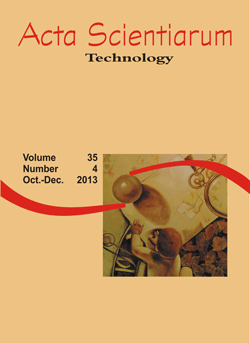<b>Thermal and microscopic analysis of biodegradable laminates made from cassava flour, sorbitol and poly (butylene adipate-co-terephthalate) PBAT</b> - doi: 10.4025/actascitechnol.v35i4.13183
DOI:
https://doi.org/10.4025/actascitechnol.v35i4.13183Palavras-chave:
starch, extrusion, thermomoulding, SEM, DSCResumo
Blends of biodegradable laminated materials were developed using cassava flour as starch and natural fibers source, sorbitol as a plasticizer and PBAT as a biodegradable polyester. After obtaining pellets from three different formulations, high temperature thermopressure was used to form laminates. The characterization was performed by scanning electron microscopy (SEM) and by differential scanning calorimetry (DSC). The amount of sorbitol for the best extrusion process was 15% (weight/weight) and the formulation of the best homogeneity observed by microscopy was 55:40:15 (flour/sorbitol/PBAT). Although fibers were dispersed throughout the surface in the three treatments, scattered areas of fibers could be found among them. As rates of flour increased, an increase in the melting point of the laminates occurred when compared to pure PBAT.
Â
Downloads
Downloads
Arquivos adicionais
Publicado
Como Citar
Edição
Seção
Licença
DECLARAÇíO DE ORIGINALIDADE E DIREITOS AUTORAIS
Declaro que o presente artigo é original, não tendo sido submetido í publicação em qualquer outro periódico nacional ou internacional, quer seja em parte ou em sua totalidade.
Os direitos autorais pertencem exclusivamente aos autores. Os direitos de licenciamento utilizados pelo periódico é a licença Creative Commons Attribution 4.0 (CC BY 4.0): são permitidos o compartilhamento (cópia e distribuição do material em qualqer meio ou formato) e adaptação (remix, transformação e criação de material a partir do conteúdo assim licenciado para quaisquer fins, inclusive comerciais.
Recomenda-se a leitura desse link para maiores informações sobre o tema: fornecimento de créditos e referências de forma correta, entre outros detalhes cruciais para uso adequado do material licenciado.















